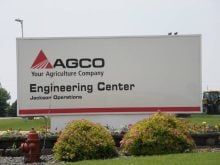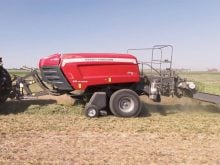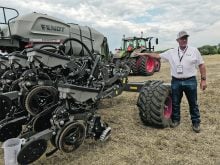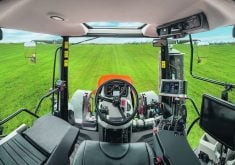After 19 years near the top of the leadership chart at Agco, senior vice-president Bob Crain retired at the end of 2024.
The Western Producer sat down with him to look back on his role in steering the company over the past two decades.
“I was lucky in my career, being able to be a part of what you might say were three key stages of the company,” he says.
Read Also

New fertilizer product aims to reduce tie-up, improve soil health
A new phosphorus fertilizer, launched at Ag in Motion 2025, promises to reduce nutrient tie-up and deliver slow-release feeding throughout the growing season.
“I was literally interviewed by our founder, Bob Ratliff. Martin (Richenhagen) pulled all the brands together, installed professional systems and processes and made significant investments into Fendt, while currently, Eric (Hansotia) is leading the company to a different level in terms of technology investments and a farmer first focus on solving customer problems.”
Agco is barely more than 30 years old, a comparative youngster in the industry, and Crain was integral in many of the early key decisions that saw it evolve from a fresh collection of different brand names to a focused agriculture equipment firm.
Among those brands acquired early on was Allis-Chalmers. When the Agco-Allis brand, seen by many as an extension of Allis-Chalmers, was officially discontinued, there were a lot of upset farmers.
However, Crain said making the decision to discontinue it and other brands was necessary.
“Going back in Agco’s history, when you’re dealing with as many brands as we once had, you’ve got to pick what you’re going to play with, because of the investment and the significant resources required. I helped make that call, picking the vital few products from a North American perspective. We couldn’t be everything to everybody. It’s impossible. Let’s pick those critical few and focus on them.”
Narrowing down the product line helped the company move forward in a number of ways, he adds, but it wasn’t without its difficulties.
“Like the distribution network, brands will be some of my biggest memories, the good, the bad and the ugly. And I’ve got scars to show for all of it. Those were tough, tough calls to make. You can argue right or wrong all day, but at some point you have to make a decision and drive a stake in the ground to enable long-term success. I think we made the right calls.”
Improving the company’s ability to support owners of both new and older equipment followed as one of his initial objectives.
“When I initially arrived, our parts support wasn’t what it should be. We took a really hard focus on parts and taking care of our customers and dealers, especially as we had so many brands.”
Crain says the early effort on parts distribution paid big dividends. For the past decade or so, Agco’s parts fill rate has been one of the best in the industry.
Along with that came the need to restructure the dealership network.
“First we had to get our house in order, such as parts and service support, which we did. We also worked on upgrading and supporting our distribution network. I would say some of the biggest progress we’ve made in the past 15 years is in the quality of our distribution network. It’s a journey; we’re still on it.”
“Because of where we came from with our acquisitions history, we had too many dealers. That was one of the biggest challenges. In many cases, dealers were competing against each other and weren’t able to build and grow into a larger, more professional, sustainable business, able to be passed on to the next generation.”
Keeping pace with the ever-increasing level of technology that producers demanded was another key challenge for a young Agco. Today, the company’s senior management has made becoming a leader in the digital realm its north star. However, getting to the point where that could be a realistic objective required significant investment as well.
“We were a company initially built on acquisitions,” Crain says.
“Bits and pieces of technology came with those acquisitions. The challenge was bringing that all together. A lot of it was disparate types of technology that solved a lot of different problems, some more critical than others. We purchased some companies specifically for the technology they brought to the party and at the same time we developed some technology ourselves.”
The acquisition of Fendt was one of the key investments that furthered that goal.
“I would argue that Fendt, going back decades, was one of the leaders in technology when we acquired it. Fendt helped us out greatly, and with Eric’s tenure, with Precision Planting, with the Trimble joint venture and other companies’ technologies, he’s been able to bring technology to the forefront in how we solve those customer problems.”
Fendt, which was initially a tractor-only brand with its main sales region in Western Europe, has now become Agco’s premium, full-line brand. Given that Agco already owned Massey Ferguson, a well-known global brand, many in the industry were surprised the company elevated Fendt into its flagship line.
“Fendt was truly a step above in durability, productivity, the passion customers had for that brand. We saw what it could be if taken globally in the right way. But in our industry, I think it takes some time to prove that to customers.
“We have Fendt focusing on a certain customer segment and Massey focusing on a customer segment. I’m confident we got it right.”
In hindsight, Crain says he would have advanced Fendt as a global brand much earlier than the company did.
“I get asked all the time what are some of the things you’d do differently in your 19 year career. If there’s anything I could have done differently when I came onboard 19 years ago, is introduced the globalization of Fendt at that time.”
However, bringing Fendt to the world wasn’t as easy as just loading tractors onto a ship.
“Substantial investments were required at the time,” Crain says.
“Unfortunately, Fendt wasn’t row crop compliant for North and South America. To make them ready took substantial investment, and we were in the middle of an ag industry down cycle. So it wasn’t the time, but if there’s anything I could have done differently, it’s done more to bring Fendt over earlier in my career.”
Crain’s time at Agco spanned, arguably, some of the most rapid industry changes in technology, sales and customer demands since gasoline tractors replaced horses.
“The changes we’ve seen in the industry were unimaginable, and now we’re seeing a new generation coming in and taking it to the next level. One of the key drivers in that is technology, where our customers are in terms of their knowledge, needs and requirements.
“Just like I would argue yesterday’s manufacturers are not the same manufacturers of today, dealers of yesterday are not the dealers of today, certainly customers of yesterday are different than customers of today. The whole industry and customer expectations have changed. And my successor will be saying the same thing in another 15 years.
“I would argue Agco has seen more positive change than any other manufacturer out there. It’s been a great journey, and I would hope I left Agco in a better place than when I found it.
















